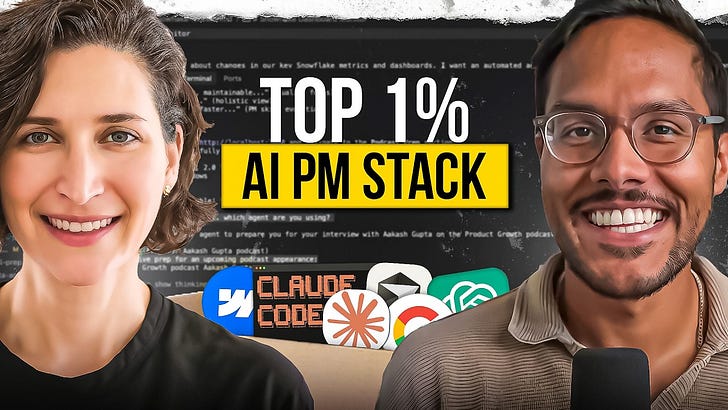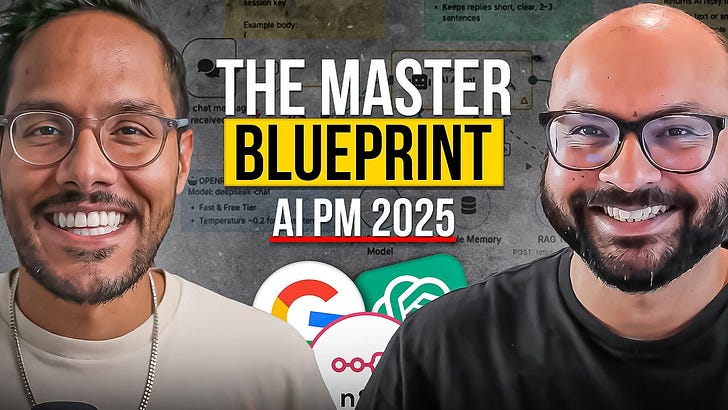Listen now on Apple, Spotify, or YouTube.
And check out our sponsors:
Amplitude: Try their 2-minute assessment of your company’s digital maturity
Maven: Get $100 off their courses with code AAKASHxMAVEN
Product Faculty: Get $500 off the AI PM certification with code AAKASH25
Today’s Episode
If you’ve seen Anthropic’s recent drop and wondered why everyone’s suddenly talking about MCP (Model Context Protocol), this episode is your primer.
Bryan Helmig, co-founder and CTO of Zapier, breaks down how MCP went from a niche dev concept to a viral protocol powering the next generation of AI agents.
But he doesn’t stop at theory. He goes LIVE to show how you can automate your workflows using MCP + Zapier + AI.
You’ll learn:
What is MCP (Model Context Protocol) – 00:03:03
Live Demo 1: AI Agent Sends Slack Message via MCP – 00:07:52
Live Demo 2: ChatGPT Drafts Gmail Replies Automatically – 00:15:56
Live Demo 3: Claude-Powered Slack Bot That Responds with Jokes – 00:23:18
How Zapier Builds AI Features – 00:31:54
Here’s a quick summary of our conversation.
10-Steps to Automating Your Email and Slack with AI via MCP
AI is no longer just about generating text or building cool tech.
With Zapier’s MCP integration, you can now give AI agents the power to take action in the real world:
From sending Slack messages to drafting emails to updating Jira tickets.
It’s like having multiple junior assistants working 24/7 for you.
In this guide, I’ll walk you through the exact steps Bryan Helmig (Zapier CTO) demoed to help product managers automate workflows using AI agents, structured APIs, and Zapier’s no-code logic.
Before You Start, 3 Things to Know:
AI agents need structure.
They aren’t magical. You have to clearly define what actions they’re allowed to take, and provide constraints for how they should operate.MCP is the bridge.
It’s a protocol that lets AI agents call actions across 30,000+ Zapier-supported tools — Slack, Gmail, Jira, Notion, and more.Reliability is your biggest challenge.
LLMs hallucinate. Workflows fail. Your job as PM is to design for failure just as much as success. Bryan calls these “sad paths” and they matter more than you think.
Now, lets’s dive into the guide.
Step 1: Understand What MCP Actually Does
MCP (Model Context Protocol) allows AI agents like ChatGPT or Claude to list, select, and execute tools dynamically.
Think of it like this:
Your AI says, “I need to send a message.”
MCP says, “Here are 10 tools available. Choose Slack.”
Then Zapier makes the actual API call.
This enables natural language agents to take real actions without needing custom backend logic.
Step 2: Connect Zapier to Your LLM
Use Zapier’s built-in integrations to hook into:
OpenAI’s ChatGPT
Anthropic’s Claude
Google’s Gemini
Once connected, you can trigger workflows like:
“Summarize this email → draft a reply → send to Gmail draft”
“Take this Slack message → generate a joke → reply in thread”
Set up the AI model you prefer and start exploring.
Step 3: Build Your First AI-Powered Slack Bot
Bryan shows you how to do it all:
Trigger: A new Slack message is posted
Action 1: Claude receives the message and generates a joke
Action 2: The bot posts the joke back in the same thread
Make sure to include safety checks:
Avoid loops (bot replying to bot)
Limit channel access
Test with real user messages, not just bots
Step 4: Try a Gmail Draft Workflow with ChatGPT
Use Zapier to:
Watch for a new email in Gmail
Feed that email to ChatGPT
Generate a response (with your tone + voice)
Save the result as a Gmail draft
Use system instructions like:“You are a helpful assistant. Write friendly, professional replies. Do not include greetings or signatures.”
This adds consistency across responses.
Step 5: Design for Failure — Not Just the Happy Path
This is where PMs go wrong. AI isn’t 100% reliable.
Example Bryan shared:
“We built a feature to generate a Zap based on user text… but users typed things like ‘Mailchimp’ or ‘my spreadsheet is broken.’ That’s not a Zap. But the AI tried to make one anyway.”
Solution:
Add validation before AI runs
Catch nonsense input
Redirect or clarify with user before triggering automation
Design UX like it’s guaranteed to fail at least once.
Step 6: Use Structured Generation, Not Freeform Text
When using LLMs, always aim for structured output.
Instead of:
“Write a joke.”
Try:
“Return a JSON object with the field
joke_textonly.”
Then map that field directly into Slack or Gmail.
It reduces hallucinations and ensures clean handoffs to downstream tools.
Structured fields = predictable automation.
Step 7: Chain Tools Together with Zapier’s Logic
Build multi-step workflows like:
Input → Claude (text classification) → Tables (log data) → Slack (summary)
Use “if/then” logic or filters inside Zapier to add branches:
If message contains "pricing", forward to sales.
If email has attachments, save to Dropbox.
This lets you create AI-driven operations systems with no code.
Step 8: Tame the Prompt
Prompt engineering = product design.
Use XML-style wrappers to clarify structure:
<email> Please reply to this event invite with a professional yes or no. </email>
Set system instructions like:
“Reply in fewer than 3 sentences.”
“Use a neutral tone unless urgency is detected.”
“Always confirm if unsure.”
Test and iterate prompts until the AI behaves consistently.
Step 9: Don’t Ignore Model Differences
This might come across not that important but it makes ALL the difference.
He shared:
“What works great with GPT-4 might totally fail with Gemini or Claude.”
So, you’ve to test across:
Claude 3.5 Sonnet
GPT-4 Turbo
Gemini 1.5 Pro
Each has quirks.
Don’t assume parity.
Zapier makes it easy to swap models in your workflows, use that to your advantage.
Step 10: Ship, Track, and Improve
After deploying your AI workflow:
Use tools like Mixpanel or PostHog to track usage.
Look at success/failure rates.
Watch for fallbacks or misfires (e.g., empty replies, misrouted tasks).
Iterate on prompts, filters, and UX to smooth out rough edges.
Use Zapier Tables to log interactions and review weekly.
Takeaways for Builders
If you’re leading AI initiatives:
Treat prompts like product specs.
Build reliability into the UX (draft mode, review checkpoints).
Use Zapier’s MCP tools to avoid building full backends.
Think “action chains” — trigger → AI model → output → delivery tool.
Where to Find Bryan
If you prefer to only get newsletter emails, unsubscribe from podcast emails here.
If you want to advertise in the podcast, email productgrowthppp at gmail.
Up Next
I hope you enjoyed the last episode with Lewis Lin (where we discussed how to nail Product Management Interviews). Up next, we have episodes with:
Kate Syuma - Ex. Head of Growth Design at Miro
David Pereira - Author of Untrapping Product Teams
Dr. Bart Jaworski - Senior PM, 125K+ on LinkedIn
Finally, check out my latest deep dive if you haven’t yet: Ultimate Guide to AI Prototyping Tools (Lovable, Bolt, Replit, v0)
Cheers,
Aakash











